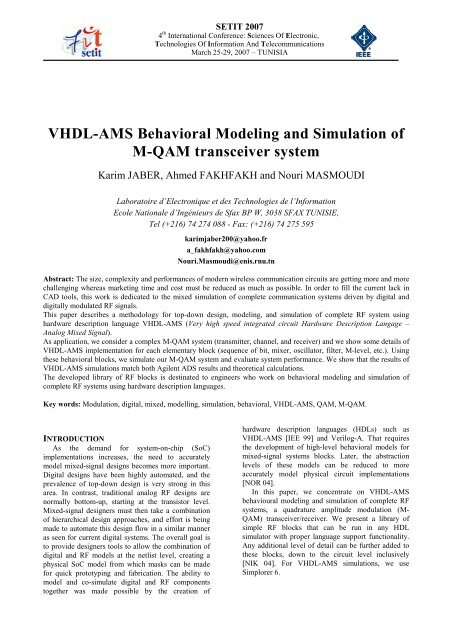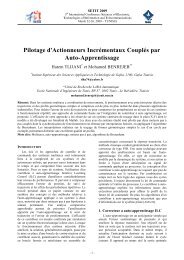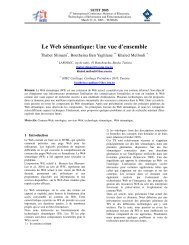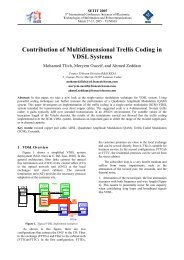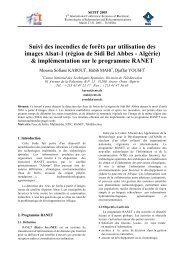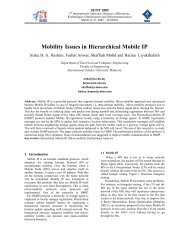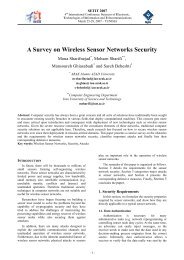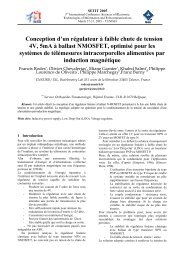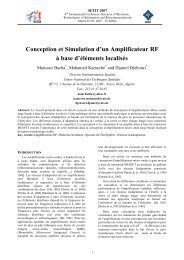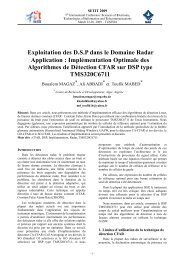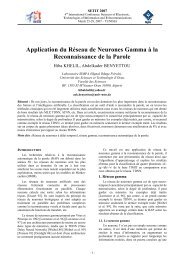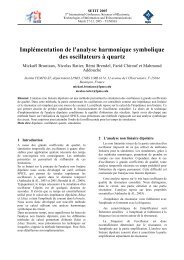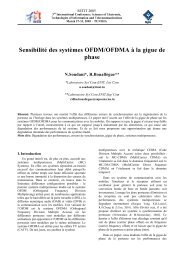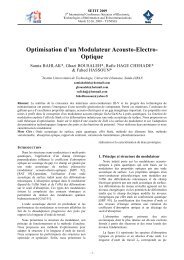VHDL-AMS Behavioral Modeling and Simulation of M-QAM ...
VHDL-AMS Behavioral Modeling and Simulation of M-QAM ...
VHDL-AMS Behavioral Modeling and Simulation of M-QAM ...
You also want an ePaper? Increase the reach of your titles
YUMPU automatically turns print PDFs into web optimized ePapers that Google loves.
SETIT 2007<br />
4 th International Conference: Sciences Of Electronic,<br />
Technologies Of Information And Telecommunications<br />
March 25-29, 2007 – TUNISIA<br />
<strong>VHDL</strong>-<strong>AMS</strong> <strong>Behavioral</strong> <strong>Modeling</strong> <strong>and</strong> <strong>Simulation</strong> <strong>of</strong><br />
M-<strong>QAM</strong> transceiver system<br />
Karim JABER, Ahmed FAKHFAKH <strong>and</strong> Nouri MASMOUDI<br />
Laboratoire d’Electronique et des Technologies de l’Information<br />
Ecole Nationale d’Ingénieurs de Sfax BP W, 3038 SFAX TUNISIE,<br />
Tel (+216) 74 274 088 - Fax: (+216) 74 275 595<br />
karimjaber200@yahoo.fr<br />
a_fakhfakh@yahoo.com<br />
Nouri.Masmoudi@enis.rnu.tn<br />
Abstract: The size, complexity <strong>and</strong> performances <strong>of</strong> modern wireless communication circuits are getting more <strong>and</strong> more<br />
challenging whereas marketing time <strong>and</strong> cost must be reduced as much as possible. In order to fill the current lack in<br />
CAD tools, this work is dedicated to the mixed simulation <strong>of</strong> complete communication systems driven by digital <strong>and</strong><br />
digitally modulated RF signals.<br />
This paper describes a methodology for top-down design, modeling, <strong>and</strong> simulation <strong>of</strong> complete RF system using<br />
hardware description language <strong>VHDL</strong>-<strong>AMS</strong> (Very high speed integrated circuit Hardware Description Langage –<br />
Analog Mixed Signal).<br />
As application, we consider a complex M-<strong>QAM</strong> system (transmitter, channel, <strong>and</strong> receiver) <strong>and</strong> we show some details <strong>of</strong><br />
<strong>VHDL</strong>-<strong>AMS</strong> implementation for each elementary block (sequence <strong>of</strong> bit, mixer, oscillator, filter, M-level, etc.). Using<br />
these behavioral blocks, we simulate our M-<strong>QAM</strong> system <strong>and</strong> evaluate system performance. We show that the results <strong>of</strong><br />
<strong>VHDL</strong>-<strong>AMS</strong> simulations match both Agilent ADS results <strong>and</strong> theoretical calculations.<br />
The developed library <strong>of</strong> RF blocks is destinated to engineers who work on behavioral modeling <strong>and</strong> simulation <strong>of</strong><br />
complete RF systems using hardware description languages.<br />
Key words: Modulation, digital, mixed, modelling, simulation, behavioral, <strong>VHDL</strong>-<strong>AMS</strong>, <strong>QAM</strong>, M-<strong>QAM</strong>.<br />
INTRODUCTION<br />
As the dem<strong>and</strong> for system-on-chip (SoC)<br />
implementations increases, the need to accurately<br />
model mixed-signal designs becomes more important.<br />
Digital designs have been highly automated, <strong>and</strong> the<br />
prevalence <strong>of</strong> top-down design is very strong in this<br />
area. In contrast, traditional analog RF designs are<br />
normally bottom-up, starting at the transistor level.<br />
Mixed-signal designers must then take a combination<br />
<strong>of</strong> hierarchical design approaches, <strong>and</strong> effort is being<br />
made to automate this design flow in a similar manner<br />
as seen for current digital systems. The overall goal is<br />
to provide designers tools to allow the combination <strong>of</strong><br />
digital <strong>and</strong> RF models at the netlist level, creating a<br />
physical SoC model from which masks can be made<br />
for quick prototyping <strong>and</strong> fabrication. The ability to<br />
model <strong>and</strong> co-simulate digital <strong>and</strong> RF components<br />
together was made possible by the creation <strong>of</strong><br />
hardware description languages (HDLs) such as<br />
<strong>VHDL</strong>-<strong>AMS</strong> [IEE 99] <strong>and</strong> Verilog-A. That requires<br />
the development <strong>of</strong> high-level behavioral models for<br />
mixed-signal systems blocks. Later, the abstraction<br />
levels <strong>of</strong> these models can be reduced to more<br />
accurately model physical circuit implementations<br />
[NOR 04].<br />
In this paper, we concentrate on <strong>VHDL</strong>-<strong>AMS</strong><br />
behavioural modeling <strong>and</strong> simulation <strong>of</strong> complete RF<br />
systems, a quadrature amplitude modulation (M-<br />
<strong>QAM</strong>) transceiver/receiver. We present a library <strong>of</strong><br />
simple RF blocks that can be run in any HDL<br />
simulator with proper language support functionality.<br />
Any additional level <strong>of</strong> detail can be further added to<br />
these blocks, down to the circuit level inclusively<br />
[NIK 04]. For <strong>VHDL</strong>-<strong>AMS</strong> simulations, we use<br />
Simplorer 6.
We try here to achieve a generic modulator, which can<br />
be adjusted for a big variety <strong>of</strong> modulations <strong>and</strong><br />
compatible with needs <strong>of</strong> telecommunications today.<br />
When the receiver exploits knowledge <strong>of</strong> the carrier’s<br />
phase to detect the signals, the process is called<br />
coherent demodulation/detection [SKL 98]. Figure 2<br />
shows a block diagram <strong>of</strong> a <strong>QAM</strong> coherent<br />
1. DESCRIPTION OF MIXED MODULATOR /<br />
DEMODULTEUR M-<strong>QAM</strong><br />
1.1. Modulator M-<strong>QAM</strong><br />
The baseb<strong>and</strong> equivalent representation, u m (t), <strong>of</strong><br />
the <strong>QAM</strong> signal can be expressed as<br />
I Q<br />
u ( t)<br />
= ( A jA ) g(<br />
t)<br />
m=1,2,…..,M<br />
(1)<br />
m m<br />
+<br />
Where<br />
m<br />
I Q<br />
A , A ∈ {±1∆,±3∆,...,±( M −1)∆} (∆ is a<br />
m<br />
m<br />
constant whose value is determined by the average<br />
transmitted power).<br />
The baseb<strong>and</strong> signal S m (t), which is chosen from one<br />
<strong>of</strong> M possible signalling waveforms is given by:<br />
s m<br />
(t) =<br />
Re{ u<br />
j 2πfct<br />
m<br />
( t)<br />
e }= Am<br />
g( t)cos(2<br />
fct<br />
θm)<br />
π + (2)<br />
f c is the intermediate carrier frequency. Alternatively,<br />
the b<strong>and</strong>pass <strong>QAM</strong> signal in (2) can be expressed<br />
equivalently in terms <strong>of</strong> its quadrature components as:<br />
I<br />
Q<br />
s m<br />
(t) = A g( t)cos(<br />
2πf<br />
t)<br />
− A g(<br />
t)sin(<br />
2πf<br />
t)<br />
(3)<br />
m<br />
c<br />
This representation leads to the most common<br />
functional representation <strong>of</strong> the <strong>QAM</strong> modulator,<br />
which is shown in Figure 1.<br />
Binary<br />
sequence<br />
(R b)<br />
Constellation<br />
encoder<br />
(R)<br />
(R)<br />
Q<br />
A<br />
m<br />
LPF<br />
g(t)<br />
LPF<br />
g(t)<br />
Figure 1: Typical <strong>QAM</strong> modulator.<br />
First, the input binary baseb<strong>and</strong> sequence with bit rate<br />
R b bits/second is encoded into two quadrature M -level<br />
pulse amplitude modulation (PAM) signals, each<br />
having a symbol rate <strong>of</strong> R= R b / K symbols/second ( K<br />
= log 2 M ). These two components <strong>of</strong> I <strong>and</strong> Q are then<br />
filtered by pulse-shaping lowpass filters (LPFs), g(t) ,<br />
to limit the transmission b<strong>and</strong>width. Finally the<br />
quadrature signals modulate the I <strong>and</strong> Q carriers for<br />
transmission. The transmitted b<strong>and</strong>pass signal S m (t) ,<br />
which is the summation <strong>of</strong> all symbols represented by<br />
the M possible signalling waveforms for <strong>QAM</strong> [PRO<br />
95], [CHE 04].<br />
1.2. Demodulator M-<strong>QAM</strong><br />
Since the information is carried in the phase <strong>and</strong><br />
amplitude <strong>of</strong> the modulated carrier for the <strong>QAM</strong><br />
signal, the receiver is assumed to be able to generate a<br />
reference carrier whose frequency <strong>and</strong> phase are<br />
identical to those <strong>of</strong> the carrier at the transmitter.<br />
m<br />
LO<br />
90°<br />
c<br />
cos(2πf ct)<br />
-sin(2πf ct)<br />
s m (t)<br />
demodulator.<br />
Figure 2: Block diagram <strong>of</strong> a <strong>QAM</strong> coherent<br />
demodulator.<br />
At the receiver, the received high frequency signal is<br />
first down-converted to a lower intermediate frequency<br />
(IF) before being further processed. The demodulator<br />
performs the majority <strong>of</strong> its work at an intermediate or<br />
baseb<strong>and</strong> frequency. The mixer in the coherent<br />
demodulator converts the IF signal to a baseb<strong>and</strong><br />
signal, by multiplying the incoming IF signal with a<br />
locally generated carrier reference <strong>and</strong> the product is<br />
passed through a lowpass filter (LPF). The LPF<br />
removes the high-frequency components <strong>and</strong> selects<br />
the difference component from the mixer output.<br />
These LPFs also perform as matched filters whose<br />
impulse responses are matched to the transmitted<br />
signal to provide the maximum signal-to-noise ratio<br />
(SNR) at their output. Then detectors decide which <strong>of</strong><br />
the possible signal waveforms was transmitted from<br />
the output <strong>of</strong> the LPFs.<br />
2. <strong>VHDL</strong>-<strong>AMS</strong> IMPLEMENTATION OF M-<br />
<strong>QAM</strong> SYSTEM<br />
Our work is focused on the development <strong>of</strong> a<br />
complete <strong>VHDL</strong>-<strong>AMS</strong> library containing high level<br />
descriptions <strong>of</strong> the most commun modulation <strong>and</strong><br />
demodulation techniques like ASK, PSK, QPSK, <strong>and</strong><br />
<strong>QAM</strong>. We will only focused in this paper on the<br />
presentation <strong>of</strong> a generic M-<strong>QAM</strong><br />
modulator/demodulator.<br />
A highly ideal system, modeled after the theoretical<br />
<strong>QAM</strong> system, is implemented in <strong>VHDL</strong>-<strong>AMS</strong>. To<br />
better manage the number <strong>of</strong> components involved in<br />
this design, the code hierarchy in Figure 3 is<br />
implemented. Each block contains the components<br />
needed to perform its intended function. The <strong>QAM</strong><br />
system wrapper is used to initialize variables<br />
concerning only the RF system: transmitter, <strong>and</strong><br />
receiver.<br />
. Binary<br />
sequence<br />
Transmitter<br />
‘M-<strong>QAM</strong>’<br />
Channel<br />
Figure 3: Basic M-<strong>QAM</strong> code hierarchy <strong>of</strong> <strong>VHDL</strong>-<br />
<strong>AMS</strong> model.<br />
Receiver<br />
2
2.1. Transmitter M-<strong>QAM</strong><br />
The transmitter block diagram is shown on Figure 4.<br />
Figure 4: Transmitter bloc diagram.<br />
The architecture <strong>of</strong> the modulator can be separate<br />
in several functional blocks, witch can be studied<br />
separately:<br />
-The block <strong>of</strong> serial to parallel: the binary sequence<br />
(serial data) is converted to N-bit (M=2 N ).<br />
-The generation block <strong>of</strong> M-levels (modulator i(t)/q(t))<br />
produces the two ways In-phase i(t) <strong>and</strong> Quadraturephase<br />
q(t). It integrates a digital to analog converter<br />
-The modulation block produces the modulated signal.<br />
The goal is to support a coding adapted to several<br />
types <strong>of</strong> modulations. The coder will accept<br />
modulations QPSK <strong>and</strong> 4-<strong>QAM</strong> until 256-<strong>QAM</strong>.<br />
2.1.1. Serial to parallel<br />
The binary input stream is subdivided into block <strong>of</strong><br />
N bits, called symbols, <strong>and</strong> each symbol is represented<br />
by one <strong>of</strong> M=2 N pulse amplitude values.<br />
The incoming N bits are considered in groups <strong>of</strong> N<br />
bits. The block diagram <strong>of</strong> a M-<strong>QAM</strong> transmitter is<br />
shown on Figure 4. The input binary data are divided<br />
into N channels: I 0 , I 1 …. I (N/2)-1 , <strong>and</strong> Q 0 , Q 1 ,……,<br />
Q (N/2)-1 . The bit rate in each channel is fb/N. N bits<br />
are serially clocked into the serial-to-parallel block.<br />
The serial to parallel block used shift register to N bits<br />
<strong>and</strong> N latch D shown on Figure 5.<br />
2.1.2. M-level <strong>QAM</strong><br />
In M-level <strong>QAM</strong> the bit data is suitably assembled<br />
into N symbols (M=2 N ) <strong>and</strong> each symbol transmitted<br />
by a carrier wave having a unique amplitude <strong>and</strong><br />
phase. The duration <strong>of</strong> each symbol determines the<br />
b<strong>and</strong>width <strong>of</strong> the <strong>QAM</strong> signal. Fig.6 shows a M-level<br />
constellation where each dot represents the position <strong>of</strong><br />
the phasor relative to the intersection <strong>of</strong> the axes<br />
marked I (for in phase) <strong>and</strong> Q (for Quadrature) [HAN<br />
90].<br />
The phasors <strong>of</strong> the M-level constellation may be<br />
decomposed into N/2 independent N-level AM signals<br />
that are transmitted on quadrature components <strong>of</strong> the<br />
same carrier.<br />
Each AM carrier is transmitted with an amplitude <strong>of</strong><br />
either -(N-1)d,……, -3d, -d, d, 3d,…….., (N-1)d,<br />
where d is the coordinate spacing shown in Fig.6.<br />
The N-level AM components are binary encoded using<br />
N/2 Gray coded bits for each level. For example, the<br />
4-level AM components <strong>of</strong> 16-<strong>QAM</strong> are binary<br />
encoded using two Gray coded bits for each level;<br />
Gray codes 01, 00, 10 <strong>and</strong> 11, are assigned to levels<br />
3d, d, -d <strong>and</strong> 3d, respectively [YEA 03].<br />
Origin<br />
Q<br />
01<br />
00<br />
10<br />
11<br />
M-<strong>QAM</strong> (M=16)<br />
3d<br />
d<br />
-d<br />
Q<br />
-3d d d 3d<br />
Origin<br />
-3d -d d 3d<br />
11 10 00 01<br />
I<br />
I<br />
-3d<br />
Modulation <strong>QAM</strong> <strong>of</strong> 2 N states<br />
Horloge T<br />
Horloge NT<br />
Shift register to N bits<br />
Binary sequence<br />
Latch D<br />
Figure 5: Serial to parallel block.<br />
I0Q0I1Q2<br />
Figure 6: M-ary <strong>QAM</strong> constellation, M=16.<br />
The mapping <strong>of</strong> the bits into symbols is frequently<br />
done in accordance with the Gray code which helps to<br />
minimize the number <strong>of</strong> bit errors occurring for every<br />
symbol error. Because Gray-coding is given to a bit<br />
assignment where the bit patterns in adjacent symbols<br />
only differ by one bit [BAT 99], this code ensures that<br />
a single symbol in error likely corresponds to a single<br />
bit in error.<br />
Finally, we mixed the I channel with cos(ω c t) <strong>and</strong> Q<br />
channel with sin(ω c t). The resulting signals are then<br />
summed <strong>and</strong> amplified by an ideal power amplifier.<br />
3
2.2 Receiver<br />
The receiver diagram block is depicted on Figure 7.<br />
The signal is first amplified <strong>and</strong> then down converted<br />
by mixing it with the sine <strong>and</strong> cosine <strong>of</strong> the carrier<br />
frequency.<br />
Then, the obtained signals passe through low-pass<br />
filters, creating the reconstructed I <strong>and</strong> Q channels.<br />
The I <strong>and</strong> Q channels output from the demodulator are<br />
then digitized in N bit <strong>and</strong> passed to the parallel to<br />
serial converter, where they are sampled using the<br />
recovered symbol clock, hard limited, <strong>and</strong> output<br />
serially from the binary sequence.<br />
2<br />
-2<br />
2<br />
-2<br />
2<br />
-2<br />
2<br />
-2<br />
0 2u 4u 6u 8u<br />
10u t [s]<br />
Figure 9(a): Inphase <strong>and</strong> Quadrature for 4-<br />
<strong>QAM</strong>(M=4).<br />
gen_bit.val<br />
inphase.val<br />
quadrature.val<br />
inp_estime.VAL<br />
quad_estime.VAL<br />
4<br />
Inphase.input0<br />
0<br />
-4<br />
s m (t)<br />
LO<br />
cos(2πf ct)<br />
LPF<br />
A/D<br />
Parallel<br />
to serial<br />
4<br />
0<br />
-4<br />
2<br />
0<br />
-2<br />
Quadrature.input0<br />
I_Filter.VAL<br />
90°<br />
-sin(2πf ct)<br />
LPF<br />
2<br />
0<br />
-2<br />
5u 10u 15u 20u 25u<br />
0 29u<br />
t [s]<br />
Q_Filter.VAL<br />
Figure 7: Block diagram <strong>of</strong> <strong>VHDL</strong>-<strong>AMS</strong> M-<strong>QAM</strong><br />
receiver.<br />
10<br />
0<br />
-10<br />
Figure 9(b): Inphase <strong>and</strong> Quadrature for 16-<br />
<strong>QAM</strong> (M=16).<br />
Inphase.input0<br />
3. SIMULATION RESULTS<br />
The <strong>VHDL</strong>-<strong>AMS</strong> description developed for the<br />
transmitter/receiver M-<strong>QAM</strong> system is based on the<br />
principe detailed above.<br />
The obtained high level model is generic <strong>and</strong> gives<br />
the possibility to the user to choice the M-<strong>QAM</strong><br />
modulation technique.<br />
Figure 8 shows four waveforms. Digital data,<br />
inphase, quadrature <strong>and</strong> the 4-<strong>QAM</strong> modulated signal<br />
obtained after the transmitter model simulation.<br />
10<br />
0<br />
-10<br />
5<br />
0<br />
-5<br />
4<br />
0<br />
-4<br />
5u 10u 15u 20u<br />
0 26u<br />
Quadrature.input0<br />
I_Filter.VAL<br />
Q_Filter.VAL<br />
Figure 9(c): Inphase <strong>and</strong> Quadrature for 64-<strong>QAM</strong><br />
(M=64).<br />
Figure 10 shows 4-<strong>QAM</strong> the constellation in the<br />
transmitter <strong>and</strong> in the receiver (after filtering).<br />
t [s]<br />
gen_bit.val<br />
2<br />
-2<br />
inphase.val<br />
1.3<br />
4_<strong>QAM</strong><br />
2<br />
-2<br />
quadrature.val<br />
1<br />
2<br />
-2<br />
signal_mod.val<br />
0.5<br />
0<br />
0 1u 2u 3u 4u 5u<br />
6u t [s]<br />
-0.5<br />
Figure 8: 4-<strong>QAM</strong> Transmitter.<br />
Figure 9 (a,b,c) shows the signals I <strong>and</strong> Q in the<br />
transmitter, I <strong>and</strong> Q channels in the receiver (after<br />
filtering) respectively for 4 <strong>QAM</strong>, 16 <strong>QAM</strong> <strong>and</strong> 64<br />
<strong>QAM</strong>. We can see that in all cases we receive the<br />
same transmitted information.<br />
-1<br />
-1.3<br />
0<br />
-1.5 -1 -0.5 0.5 1 1.5<br />
-2 2<br />
Figure 10: Constellation 4-<strong>QAM</strong> (M=4)<br />
4
With the generic model that we have developped <strong>and</strong><br />
simulated, we can draw the spectrum <strong>of</strong> the modulated<br />
signal. Figures 11(a), (b) <strong>and</strong> (c) represent respectively<br />
spectrums <strong>of</strong> the modulation 16 <strong>QAM</strong>, 32 <strong>QAM</strong> <strong>and</strong><br />
64 <strong>QAM</strong><br />
-0.17Meg<br />
1.003<br />
5.00Meg<br />
10.00Meg<br />
15.00Meg<br />
20.00Meg<br />
25.00Meg<br />
sum1....<br />
0.750 0.750<br />
0.500 0.500<br />
0.250 0.250<br />
0 0<br />
-0.17Meg 5.00Meg<br />
10.00Meg<br />
15.00Meg<br />
20.00Meg 25.00Meg<br />
-0.25Meg<br />
1000.0m<br />
5.00Meg<br />
10.00Meg<br />
(a)<br />
15.00Meg<br />
20.00Meg<br />
25.02Meg<br />
sum1....<br />
750.0m 750.0m<br />
500.0m 500.0m<br />
250.0m 250.0m<br />
0 0<br />
-0.25Meg 5.00Meg<br />
10.00Meg<br />
15.00Meg<br />
20.00Meg 25.02Meg<br />
-0.24Meg<br />
1.002<br />
5.00Meg<br />
10.00Meg<br />
(b)<br />
15.00Meg<br />
20.00Meg<br />
25.02Meg<br />
sum1....<br />
0.750 0.750<br />
0.500 0.500<br />
0.250 0.250<br />
0 0<br />
-0.24Meg 5.00Meg<br />
10.00Meg<br />
15.00Meg<br />
20.00Meg 25.02Meg<br />
We have shown that we are able to obtain a transient<br />
response, a constellation or a spectrum <strong>of</strong> the<br />
modulated <strong>and</strong> demodulated signals after the<br />
simulation <strong>of</strong> our <strong>VHDL</strong>-<strong>AMS</strong> description.<br />
All these results allow to study <strong>and</strong> to optimize the<br />
transmitter/receiver at a high level <strong>of</strong> design which<br />
constitutes an important step in the top-down<br />
hierarchical design flow.<br />
REFERENCES<br />
[BAT 99] A. Bateman, Digital Communications: Design for<br />
the real world, Addison-Wesley Longman Limited, New<br />
York, NY, 1999.<br />
[CHE 04] J. Chen, “CARRIER RECOVERY IN BURST-<br />
MODE 16-<strong>QAM</strong>,” thesis, University <strong>of</strong> Saskatchewan, June<br />
2004.<br />
[HAN 90] L. Hanzo, R. Steele, <strong>and</strong> P.M. Fortune “A<br />
Subb<strong>and</strong> Coding, BCH Coding, <strong>and</strong> 16-<strong>QAM</strong> System for<br />
Mobile Radio Speech Communications,” IEEE Transactions<br />
on Vehicular Technologies, 1990.<br />
[IEE 99] “<strong>VHDL</strong> Analog <strong>and</strong> Mixed-Signal Extensions:<br />
IEEE st<strong>and</strong>ard 1076.1-1999,”<br />
[NIK 04] P. Nikitin, E. Normark, C. Wakayama, <strong>and</strong> R. Shi<br />
“<strong>VHDL</strong>-<strong>AMS</strong> modeling <strong>and</strong> simulation <strong>of</strong> a BPSK<br />
transceiver system,” Proceedings <strong>of</strong> IEEE International<br />
Conference on Circuits <strong>and</strong> Systems for Communications,<br />
2004.<br />
[NOR 04] E. Normark, L. Yang, C. Wakayama, P. Nikitin,<br />
<strong>and</strong> R. Shi “<strong>VHDL</strong>-<strong>AMS</strong> Behavioural <strong>Modeling</strong> ad<br />
<strong>Simulation</strong> <strong>of</strong> a π/4 DQPSK transceiver system,” 2004.<br />
BMAS 2004. Proceedings <strong>of</strong> the Fifth IEEE International<br />
Workshop on, 10-12 Oct. 2004.<br />
[PRO 95] J. G. Proakis, Digital Communications,<br />
McGraw-Hill Inc., New York, NY, 1995 (Third Edition).<br />
[SKL 98] B. Sklar, Digital Communications:<br />
Fundamentals <strong>and</strong> Applications, PrenticeHall Inc.,<br />
Englewood Cliffs, NJ, 1998.<br />
[YEA 03] Bee Leong Yeap, Choong Hin Wong, <strong>and</strong><br />
Lajos Hanzo, “Reduced Complexity In-Phase/Quadrature-<br />
Phase M-<strong>QAM</strong> Turbo Equalization Using Iterative Channel<br />
Estimation,” IEEE Transactionson Wireless<br />
Communications, VOL. 2, NO. 1, JANUARY 2003.<br />
(c)<br />
Figure 11: Spectrum <strong>of</strong> ((a):16 <strong>QAM</strong>, (b):32<br />
<strong>QAM</strong>, (c): 64 <strong>QAM</strong>)<br />
We can see that when the number <strong>of</strong> bits increases (or<br />
symbols), the spectral clutter increases.<br />
4. CONCLUSION<br />
In this paper, we described a methodology for<br />
modelling <strong>and</strong> simulation <strong>of</strong> complete RF system using<br />
<strong>VHDL</strong>-<strong>AMS</strong>. As a demonstration example, we<br />
considered an M-<strong>QAM</strong> system. We simulated <strong>and</strong><br />
evaluated system performance <strong>and</strong> a high level <strong>of</strong><br />
description.<br />
5


